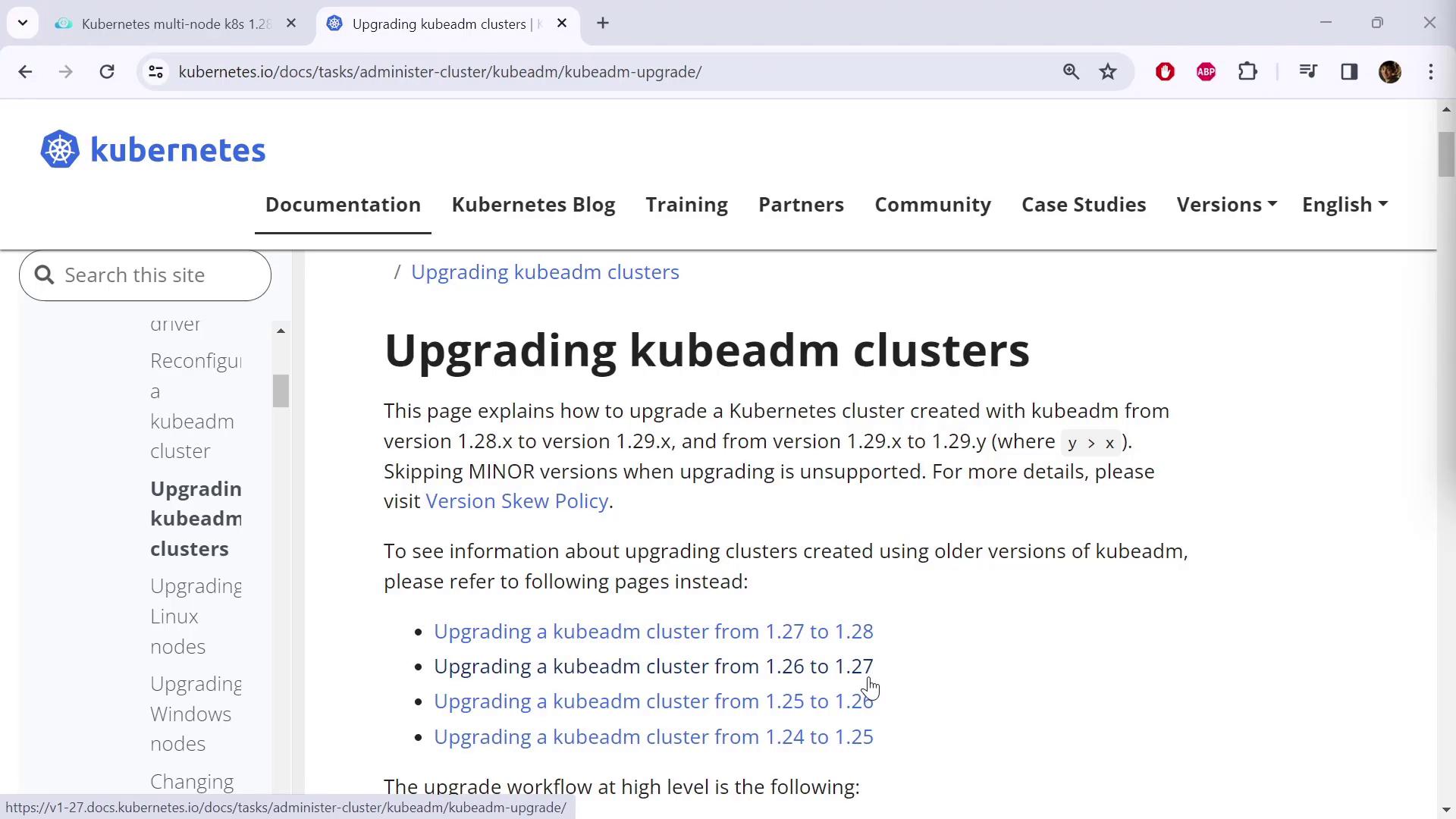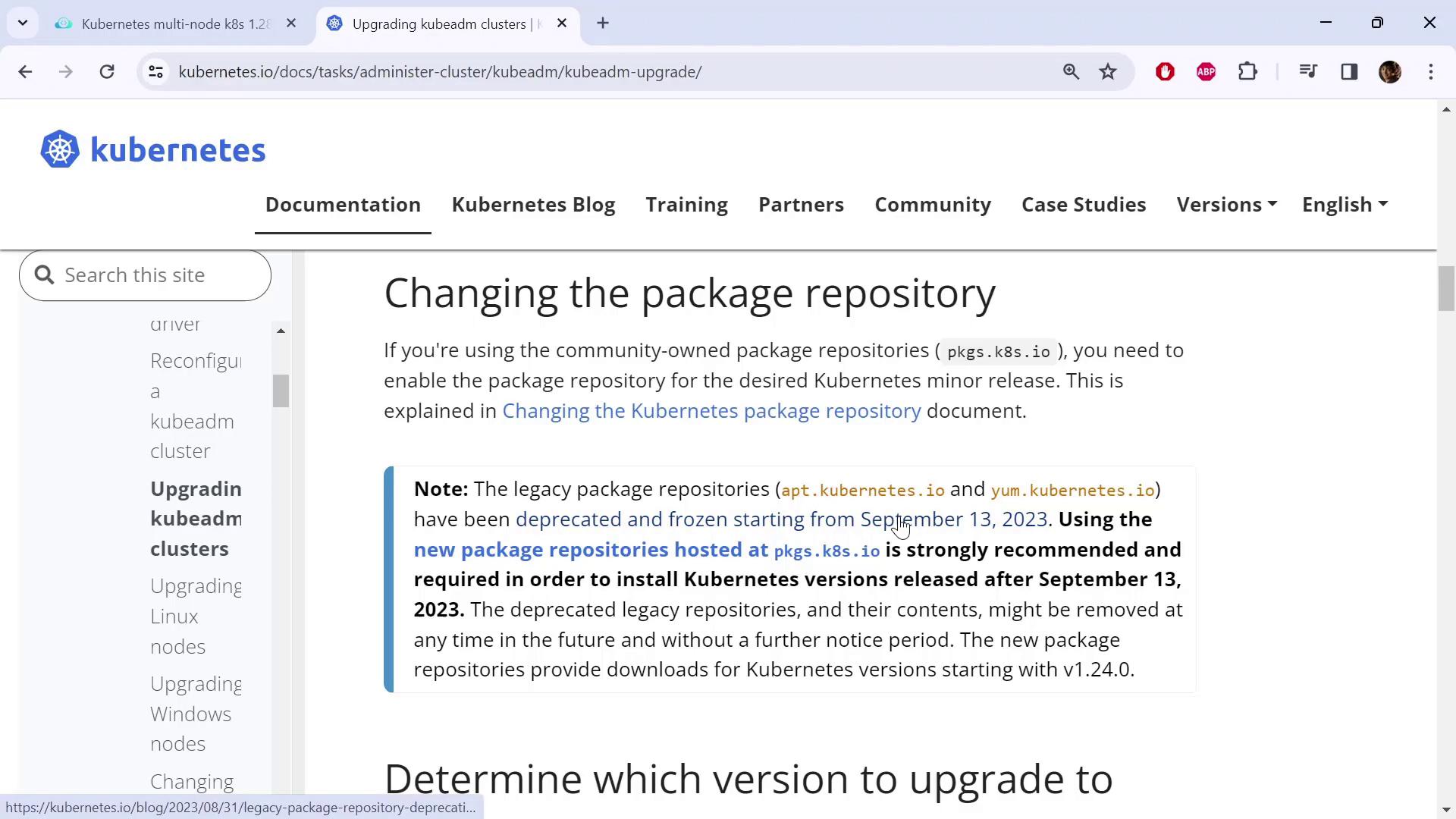Certified Kubernetes Security Specialist (CKS)
Cluster Setup and Hardening
Demo Cluster Upgrade
In this lesson, we'll demonstrate upgrading a Kubernetes cluster from version 1.28 to 1.29 using kubeadm. The procedure follows the official Kubernetes documentation under "Tasks → Administer Cluster → Administration with KubeADM → Upgrading a KubeADM Cluster." Although the documentation provides upgrade paths for various version transitions, this demo focuses on moving from v1.28 to the latest v1.29 release.

Select the upgrade path that best suits your environment and follow the provided commands. The process remains largely consistent regardless of the version specifics.
Preliminary Steps: Updating Package Repositories
Before starting the upgrade, scroll down the official documentation until you find the important note about changing the package repository. Previously, Kubernetes packages were hosted at app.kubernetes.io and yum.kubernetes.io, but these repositories have been deprecated. You must now use packages.k8s.io to download the latest versions of tools such as kubectl and kubeadm.

Note
Before proceeding, ensure that you update the package repository configuration on every cluster node.
Determine Your Operating System Distribution
To see which operating system you are using, run:
kubectl get nodes
On a two-node cluster (one control-plane and one worker node), you can verify your distribution with:
cat /etc/*release
If the output indicates Ubuntu 20.04 or another Debian-based distribution, follow the Debian/Ubuntu instructions in the documentation and update your package repository accordingly.
For instance, initially run a command like this:
echo "deb [signed-by=/etc/apt/keyrings/kubernetes-apt-keyring.gpg] https://pkgs.k8s.io/core:/stable:/v1.23/deb/ /" | sudo tee /etc/apt/sources.list.d/kubernetes.list
curl -fsSL https://pkgs.k8s.io/core/stable/v1.28/deb/Release.key | sudo apt-key add -
To upgrade to v1.29, adjust the version in the command as follows:
echo "deb [signed-by=/etc/apt/keyrings/kubernetes-apt-keyring.gpg] https://pkgs.k8s.io/core:/stable:/v1.29/deb/ /" | sudo tee /etc/apt/sources.list.d/kubernetes.list
curl -fsSL https://pkgs.k8s.io/core/stable/v1.29/deb/Release.key | sudo gpg --dearmor -o /etc/apt/keyrings/kubernetes-apt-keyring.gpg
After modifying the repository configuration on both control-plane and worker nodes, refresh the package list:
sudo apt-get update
Determining the Target Version
To identify the latest available version in the 1.29 series, use these commands:
sudo apt update
sudo apt-cache madison kubeadm
You should see output resembling:
kubeadm | 1.29.3-1 | https://pkgs.k8s.io/core/stable/v1.29/deb Packages
kubeadm | 1.29.2-1 | https://pkgs.k8s.io/core/stable/v1.29/deb Packages
kubeadm | 1.29.1-1 | https://pkgs.k8s.io/core/stable/v1.29/deb Packages
kubeadm | 1.29.0-1 | https://pkgs.k8s.io/core/stable/v1.29/deb Packages
Select the highest version available (for example, 1.29.3-1) and note it for subsequent steps.
Upgrading the Control Plane Node
Step 1: Upgrade the kubeadm Tool
First, update kubeadm on the control plane node to prepare for the upgrade. Replace the version string with the latest version (e.g., 1.29.3-1.1):
sudo apt-mark unhold kubeadm && \
sudo apt-get update && \
sudo apt-get install -y kubeadm='1.29.3-1.1' && \
sudo apt-mark hold kubeadm
Verify the upgrade by checking the version:
kubeadm version
Expected output:
kubeadm version: &version.Info{Major:"1", Minor:"29", GitVersion:"v1.29.3", GitCommit:"6813625b7cd706db5c7388921be03071e14a294", GitTreeState:"clean", BuildDate:"2024-03-15T00:06:16Z", GoVersion:"go1.21.8", Compiler:"gc", Platform:"linux/amd64"}
Step 2: Run the Upgrade Plan
Before applying the upgrade, conduct a dry run to see the available upgrade options. This command will outline which components upgrade automatically and those requiring manual updates (e.g., kubelet):
sudo kubeadm upgrade plan
The output should indicate that your cluster is currently at v1.28.0 with the target control plane version of v1.29.3. Typically, kubeadm upgrades essential components such as the API server, controller manager, scheduler, and kube-proxy automatically, while kubelet must be updated separately.
Step 3: Apply the Upgrade
Initiate the upgrade process for the control plane:
sudo kubeadm upgrade apply v1.29.3
Monitor the progress as the system renews certificates, updates static pod manifests, and restarts components. After a successful upgrade, you may see messages similar to:
[upgrade/successful] SUCCESS! Your cluster was upgraded to "v1.29.3". Enjoy!
[upgrade/kubelet] Now that your control plane is upgraded, please proceed with upgrading your kubelets if you haven't already done so.
Keep in mind that when you verify node versions via kubectl get nodes, the displayed version corresponds to the kubelet, which will still show v1.28.0 until its upgrade is completed.
Upgrading kubelet and kubectl on the Control Plane Node
Drain the Control Plane Node
Before upgrading kubelet (which runs outside the control plane pods), drain the control plane node to ensure safe maintenance:
kubectl drain controlplane --ignore-daemonsets
Upgrade kubelet and kubectl
Next, update kubelet and kubectl on the control plane node by specifying the target version:
sudo apt-mark unhold kubelet kubectl && \
sudo apt-get update && \
sudo apt-get install -y kubelet='1.29.3-1.1' kubectl='1.29.3-1.1' && \
sudo apt-mark hold kubelet kubectl
Restart the kubelet service to apply the changes:
sudo systemctl daemon-reload
sudo systemctl restart kubelet
Finally, confirm the node version:
kubectl get nodes
Since the control plane node might still be marked as “SchedulingDisabled” due to the drain operation, uncordon it to allow scheduling:
kubectl uncordon controlplane
Upgrading Worker Nodes
Follow a similar process to upgrade each worker node.
Step 1: Upgrade kubeadm on the Worker Node
On each worker node, upgrade kubeadm with:
sudo apt-mark unhold kubeadm && \
sudo apt-get update && \
sudo apt-get install -y kubeadm='1.29.3-1.1' && \
sudo apt-mark hold kubeadm
Then, from a control plane node, initiate the upgrade for the worker node:
sudo kubeadm upgrade node
Step 2: Drain the Worker Node
Drain the worker node to safely upgrade kubelet. Replace <node-name> with the actual name of your worker node:
kubectl drain <node-name> --ignore-daemonsets
If you encounter issues related to DaemonSet-managed pods, ensure that the --ignore-daemonsets flag is used correctly. Refer to kubectl drain --help for further details if needed.
Step 3: Upgrade kubelet and kubectl on the Worker Node
Upgrade the kubelet and kubectl packages with:
sudo apt-mark unhold kubelet kubectl && \
sudo apt-get update && \
sudo apt-get install -y kubelet='1.29.3-1.1' kubectl='1.29.3-1.1' && \
sudo apt-mark hold kubelet kubectl
Restart the kubelet service:
sudo systemctl daemon-reload
sudo systemctl restart kubelet
After the upgrade, uncordon the worker node to resume scheduling:
kubectl uncordon <node-name>
Finally, verify that all nodes are upgraded:
kubectl get nodes
Both control-plane and worker nodes should now display version v1.29.3.
Summary
This guide has detailed the process of upgrading a Kubernetes cluster using kubeadm. The critical steps include:
- Updating the package repository to
packages.k8s.io. - Determining the target version available from the repository.
- Upgrading the control plane by updating kubeadm, applying the upgrade, and then updating kubelet and kubectl.
- Draining nodes before performing kubelet upgrades and uncordoning them afterwards.
- Repeating the process on each worker node.
By following these steps, you ensure that every component of your Kubernetes cluster is updated properly, maintaining compatibility with the newer version. Happy upgrading!
Watch Video
Watch video content
Practice Lab
Practice lab